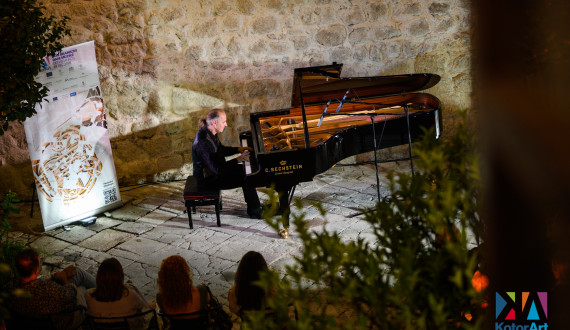Freedom of Interpretive Act
In the grand finale of this year's edition, KotorArt presented piano recitals by two exceptional pianists, Ratimir Martinović and Kemal Gekić, who captivated the audience in two separate concerts at the Monastery Complex of St. Nicholas in Prčanj. On Saturday, August 12, Gekić, just like at last year's KotorArt, thrilled the audience. The uniqueness of this year's recital lay in its program concept, or rather, its “repertoire intention.”

The program, labeled as “carte blanche,” is freely conceived by the artist during the actual concert. Gekić finds value in this approach not only in the freedom to choose compositions but also in the fact that the performer cannot predict how they will feel during a future recital. Therefore, this interpretive act implies that the KotorArt recital is a result of Gekić's immediate sensibility expressed through musical works. In this context, the pianist divided the program into two parts, playing integral selections from some of the most famous works by Frédéric Chopin, followed by a similarly integral performance of pieces by Franz Liszt. However, considering the tonal / thematic / genre-related affinities of the compositions, and the additional linkage of autonomous pieces through interpolated “bridges” stemming from Gekić's improvisations, it can be deduced that the program was approached with great expertise and thoughtfulness as a whole.
In the first section featuring Chopin's compositions, Kemal Gekić commenced with an interpretation of Nocturne Op. 9 No. 2, but in a newly discovered and recently printed version of the work, with noticeable differences in ornamentation, rhythm, and even structure, presented in an expanded form. Without pause, or attacca, the pianist continued in the same timbre, the key of E-flat major, performing the Grande Valse Brillante Op. 18. However, taking a step further in connecting the compositions, the pianist connected them with his own improvisation, creating a harmonic bridge or cadenza leading to the D-flat major of the new composition. Moreover, the Minute Waltz was foreshadowed not only by timbre but also thematically, as the end of the transition was marked with a trill, introducing the thematic material of the upcoming composition. After a very natural tonal connection with the next composition, Fantaisie-Impromptu Op. 66, since the bordering keys are in a mutational relationship (enharmonic, D-flat major and C-sharp minor), Kemal Gekić once again improvised a transition, leading to Prelude No. 15, diving into the atmosphere of the new piece via the scale of C-sharp/D-flat major and chromatics. Finally, the echo of the last chord in the Prelude, known as the Raindrop Prelude, served as a springboard to the key of the Barcarolle Op. 60. Concluding this thematic block with the grand piece, Polonaise in A-flat major, Gekić underscored Chopin's aesthetics with his elegant approach to virtuosity.
In the second part of the recital, also presented integrally, Gekić dedicated the repertoire to the works of Franz Liszt. He started with a concert piece, the third in order and the most famous from the cycle Liebesträume. This was followed by Concert Etude No. 3, subtitled Un sospiro (A Sigh), and, in the same key and mood, the third piece from the Consolations cycle. As one of the greatest connoisseurs of Liszt's works among contemporary pianists, Gekić has long emphasized the significance of the composer's transcriptive work, including the Paraphrase on Verdi's opera Rigoletto. To conclude, the pianist performed the popular Hungarian Rhapsody No. 2, punctuating the resplendent brilliance of his virtuosity.
By approaching the aesthetics of these two contemporaries and key figures in 19th-century pianism and presenting diverse piano genres, Gekić crafted a unique recital concept that points to the different societal role of music in that era. It also sheds light on the role of the interpreter and their connection with the audience in the act of interpretation. In this regard, it raises the question of whether Gekić's frequent glances towards the audience during his performance are an indicator of the necessary intimacy between the artist and the audience – an intimacy that has evolved over the historical journey from interpretation in the relaxed atmosphere of aristocratic salons to interpretation in the serious atmosphere of concert halls.
Boris Marković
